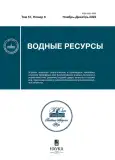Моделирование формирования стока рек горного Крыма в современных и прогнозируемых климатических условиях
- Авторы: Калугин А.С.1, Мотовилов Ю.Г.1, Попова Н.О.1, Миллионщикова Т.Д.1
-
Учреждения:
- Институт водных проблем РАН
- Выпуск: Том 51, № 6 (2024)
- Страницы: 796-805
- Раздел: ГИДРОЛОГИЧЕСКИЕ ПРОБЛЕМЫ ВОДОДЕФИЦИТНЫХ РЕГИОНОВ
- URL: https://journals.eco-vector.com/0321-0596/article/view/684431
- DOI: https://doi.org/10.31857/S0321059624060068
- EDN: https://elibrary.ru/VOZFUB
- ID: 684431
Цитировать
Полный текст
Аннотация
Модель формирования стока ECOMAG применена для расчетов физически обоснованных изменений вод ного режима рек горного Крыма в XXI в. с использованием данных ансамбля климатических моделей с учетом различных сценариев глобального потепления. Объектами исследования были реки Черная, Бельбек, Дерекойка, Альма, Салгир, Бурульча, Тонас, Кучук-Карасу, Индол. Модели формирования естественного речного стока для указанного набора речных бассейнов построены на основе однородных источников информации о гидрометеорологическом режиме и параметрах подстилающей поверхности. Верификация гидрологических моделей проводилась путем сопоставления фактических и рассчитанных среднесуточных и среднемесячных расходов воды на различных гидрометрических постах за многолетний период. Затем с помощью гидрологических моделей по данным ансамбля глобальных климатических моделей относительно базового периода 2006–2020 гг. были оценены сценарные будущие изменения стока рек за год, условно теплый и холодный сезоны года. При реализации любого из RCP-сценариев в ближайшей перспективе на 2021–2050 гг., равно как и при сценариях RCP 2.6 и RCP 4.5 в конце XXI в., дефицит водных ресурсов может отмечаться в основном в речных бассейнах, расположенных к востоку от верховьев Салгира, впрочем, не достигая катастрофических показателей. Согласно более агрессивным климатическим сценариям RCP 6.0 и RCP 8.5, в конце XXI в. вероятно наибольшее сокращение стока рек горного Крыма, что будет способствовать развитию дефицита водных ресурсов за счет атмосферных источников.
Ключевые слова
Полный текст
Об авторах
А. С. Калугин
Институт водных проблем РАН
Автор, ответственный за переписку.
Email: andrey.kalugin@iwp.ru
Россия, Москва, 119333
Ю. Г. Мотовилов
Институт водных проблем РАН
Email: andrey.kalugin@iwp.ru
Россия, Москва, 119333
Н. О. Попова
Институт водных проблем РАН
Email: andrey.kalugin@iwp.ru
Россия, Москва, 119333
Т. Д. Миллионщикова
Институт водных проблем РАН
Email: andrey.kalugin@iwp.ru
Россия, Москва, 119333
Список литературы
- Дунаева Е.А., Попович В.Ф., Ляшевский В.И. Анализ динамики количественных и качественных характеристик водных ресурсов с использованием открытых ГИС и агрогидрологических моделей // Науч. журн. РосНИИПМ. 2015. № 1 (17). С. 127–141.
- Землянскова А.А., Макарьева О.М., Нестерова Н.В., Федорова А.Д. Моделирование формирования сток горной реки Дерекойки (полуостров Крым) // Сб. докл. международ. науч. конф. памяти выдающегося русского ученого Ю.Б. Виноградова “Четвертые Виноградовские чтения. Гидрология: от познания к мировоззрению”. СПб.: Изд-во ВВМ, 2020. С. 78–83.
- Калугин А.С., Мотовилов Ю.Г., Попова Н.О., Миллионщикова Т.Д. Модели формирования стока рек горного Крыма // Свид. гос. регистрации программы для ЭВМ № 2023687573. 2023. Правообладатель ИВП РАН.
- Мотовилов Ю.Г., Гельфан А.Н. Модели формирования стока в задачах гидрологии речных бассейнов. М.: РАН, 2018. 300 с.
- Семенов В.А., Алешина М.А. Сценарные прогнозы изменений температурного и гидрологического режима Крыма в XXI веке по данным моделей климата CMIP6 // Вод. ресурсы. 2022. Т. 49. № 4. С. 506–516.
- Gelfan A.N., Gusev E.M., Kalugin A.S., Krylenko I.N., Motovilov Y.G., Nasonova O.N., Millionshchikova T.D., Frolova N.L. Runoff of Russian rivers under current and projected climate change. Rev. 2. Сlimate change impact on the water regime of Russian rivers in the XXI century // Water Resour. 2022. V. 49. № 3. P. 351–365.
- Gelfan A.N., Kalugin A.S., Motovilov Y.G. Assessing Amur water regime variations in the XXI century with two methods used to specify climate projections in river runoff formation model // Water Resour. 2018. V. 45. № 3. P. 307–317.
- Gupta H.V., Kling Y., Yilmaz K.K., Martinez G.F. Decomposition of the mean squared error and NSE performance criteria: Implications for improving hydrological modeling // J. Hydrol. 2009. V. 377. № 1–2. P. 80–91.
- Hempel S., Frieler K., Warszawski L., Schewe J., Piontek F. A trend-preserving bias correction – the ISI-MIP approach // Earth System Dynamics. 2013. V. 4. P. 219–236.
- Kalugin A. Future climate-driven runoff change in the large river basins in Eastern Siberia and the Far East using process-based hydrological models // Water. 2022. V. 14(4). № 609. P. 1–22.
- Kalugin A.S. River runoff in European Russia under global warming by 1.5 and 2 degrees // Water Resour. 2023. V. 50. № 4. P. 543–556.
- Poggio L., de Sousa L.M., Batjes N.H., Heuvelink G.B.M., Kempen B., Ribeiro E., Rossiter D. SoilGrids 2.0: producing soil information for the globe with quantified spatial uncertainty // Soil. 2021. V. 7. P. 217–240.
- Svisheva I.A., Anisimov A.E. Numerical Modeling of Extreme Flash Flood in Yalta in September 2018 // Ecol. Safety Coastal and Shelf Zones of Sea. 2022. V. 3. P. 43–53.
- Takaku J., Tadono T., Doutsu M., Ohgushi F., Kai H. Updates of “AW3D30” ALOS global digital surface model with other open access datasets // Int. Arch. Photogramm. Remote Sens. Spatial Inf. Sci. 2020. P. 183–189.
- Zhang X., Liu L., Chen X., Gao Y., Xie S., Mi J. GLC_FCS30: Global land-cover product with fine classification system at 30 m using time-series Landsat imagery // Earth System Sci. Data. 2021. V. 13. P. 2753–2776.
Дополнительные файлы















